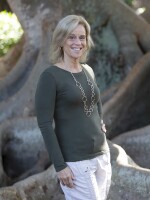It's early morning in Bradenton, where about 100 volunteers armed with shovels and pruning shears kneel in about half an acre of fresh soil for a community planting.
Manatee County master gardener Norma Kisida, crouches down and grabs a sapling.
"We're going to clip these roots so it will come out of the pot,” she says to a local school group. “Oh yeah, we don't want big roots,” answers an enthusiastic young volunteer.
By the end of the day, these gardeners will have planted about 1,800 shrubs and trees to create a microforest, a tiny densely-planted wooded area, at Heritage Harbor, a planned community just east of I-75.

Charles Reith, with the nonprofit group Sarasota Urban Reforesters, says a coalition of community groups, including Florida Veterans for Common Sense, Solutions to Avoid Red Tide, (START) and the Sarasota Bay Rotary Club, have established several microforests throughout the Gulf Coast region.
They hope that when these small but dense forests mature, they will make an impact in the fight against climate change.
The project was inspired by Japanese botanist Akira Miyawaki, who pioneered the technique of planting species close together so they compete for sunlight.
“Because of the density, the canopy trees get these shade signals in early morning and late afternoon light that stimulate hormones to grow as fast as possible," Reith said.
That means a microforest will mature in just decades instead of up to a century.
Advocates for the Miyawaki method say the miniature forests grow 10 times faster and become 30 times denser and 100 times more biodiverse than those planted by conventional methods.
Reith, a self-described sustainability activist and former professor at Tulane University in New Orleans, says as a result, the trees planted in Bradenton will be able to absorb high levels of carbon much sooner than a traditional forest.
The team estimates that a microforest planted at the Celery Fields in Sarasota two years ago, will sequester approximately 600 tons of carbon in 30 years.

Gene Jones, the president of the nonprofit Florida Veterans for Common Sense, says another major benefit is that microforests intercept and filter rainwater and help reduce pollutants that flow into waterways.
"Runoff contributes a lot to the nutrient load in our bay, which exacerbates red tide,” he said.
These small forests are becoming increasingly popular, particularly in urban areas where space is tight, because they can fit pretty much anywhere. The one in Bradenton is the fifth of its kind in the Gulf Coast region.
Brad Oberle, a professor of biology and environmental studies at New College of Florida is helping organizers track the amount of carbon these microforests will eventually store.
Oberle helped create a food forest with New College students on just under an acre of the Sarasota campus in 2015.
“If we can understand how to make forests grow even better, we potentially have a really powerful tool to combat climate change," he said.
The New College team measured their trees two years after the initial planting. Taking the soil and trees together, Oberle said the tiny food forest pulled 20,000 pounds of carbon dioxide out of the air. That’s equal to the amount produced by two households in a year.

At double the size, and with larger trees, the microforest in Bradenton should sequester a lot more.
That's important because more carbon in the air means a warmer planet.
According to the Florida Climate Center, 2022 was the 12th year in a row the state experienced above average temperatures.
An additional benefit of micro forests is that they help reduce what's known as the urban heat effect, which is created when natural land is replaced with development.
“These microforests create a zone certainly under them, but extending further out than one might expect, that cools the air down considerably," said Reith.

While the most obvious way trees cool the air is by shading, they also do it through transpiration, which happens when trees release water into the atmosphere from their leaves.
As the water turns from liquid into vapor, the surrounding air is cooled.
And while even proponents say microforests won’t solve climate change by themselves, Reith says these hyperlocal patches of nature can help, especially when they are multiplied.
"The best way to combat climate change is to engage a lot of people,” he said.” And to have these kinds of forests in every neighborhood."






